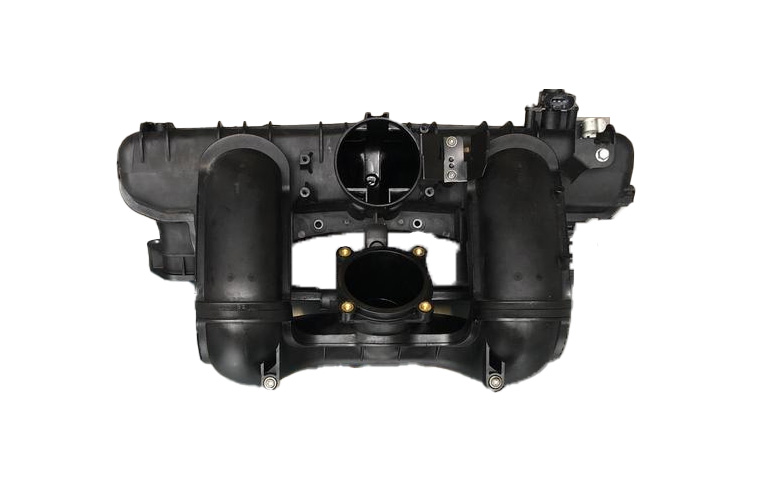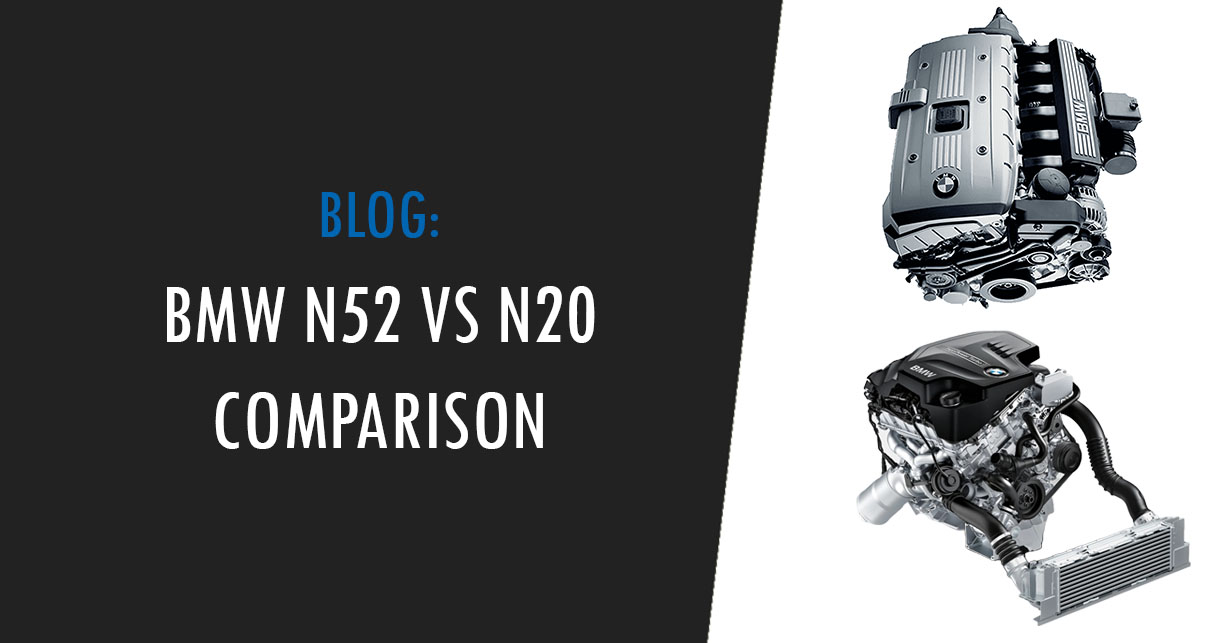BMW introduced the N20 engine as a direct replacement for the N52, producing almost the same horsepower, with higher torque and better efficiency. This was a turning point in the Bavarian manufacturer’s history as BMW has long been recognized for engineering excellent naturally-aspirated inline-six engines.
How do the BMW N52 and the N20 compare to each other in terms of power delivery, reliability, tuning, fuel efficiency, and sound?
BMW N52 vs. BMW N20 Specifications

| N52 (N52B30) | N20 (N20B20) | |
|---|---|---|
| Max. Horsepower | 268 hp at 6,650 RPM | 241 hp at 5,000 RPM |
| Max. Torque | 232 lb-ft at 2,750 RPM | 258 lb-ft at 1,250-4,800 RPM |
| Configuration | Inline-6 | Inline-4 |
| Induction | Naturally aspirated | Single twin-scroll turbo |
| Fuel Injection | Port Injection | Direct Injection |
| Displacement | 2,996 cc (3.0 L) | 1,997 cc (2.0L) |
| Compression Ratio | 10.7:1 | 10.3:1 |
| Bore and Stroke | 85 mm x 88 mm | 84 mm x 90.1 mm |
| Block Material | Magnesium and Aluminium | Aluminium |
| Redline | 7,000 RPM | 7,000 RPM |
N52 vs. N20 Engine Overview
The N52 is the M54 successor. It was BMW’s bread and butter for a decade and powered cars from the 1 Series all the way to the 7 Series. It was the last naturally-aspirated inline-6 along with its direct-injected brother, the N53.
Although the N52 isn’t a particularly powerful engine, its smoothness, refinement, linear power, and reliability have been praised by drivers looking for a practical daily driver.
The N20 marked a departure from tradition with its turbocharged inline-four configuration. Although BMW purists and enthusiasts resented the move, tightening regulations, and improved fuel efficiency were some of the biggest reasons to switch to a smaller turbocharged engine.
N52 vs. N20 Horsepower & Torque
The BMW N52 has very different power delivery when compared to the N20 engine. The N52 produces 268 horsepower and 232 lb-ft of torque in its highest output version, while the N20 engine produces 241 horsepower and 258 lb-ft of torque.
Although the power figures above appear similar on paper, the real-world driving experience highlights very distinct engine characteristics.
The N20 produces 15 fewer hp than the N52 straight-six but has 40 lb-ft greater torque. The N52 has linear power with torque in the middle-to-upper RPM range, whereas the N20 has a lot of torque on the low-end of the RPM range.
The N20 outputs higher torque at lower RPMs, while the N52 shines at the upper end
The N52 delivers power in a linear manner, with torque building up in the middle-to-upper RPM range. To exploit the horsepower of the N52 you’ll need to rev it way beyond 4,000 RPM, as it produces its peak HP at 6,650 RPM.
The N20 engine excels in regular city driving, where its abundant low-end torque makes it feel more powerful than the N52. The N20 strikes the proper combination between performance and efficiency, and it will feel like a more powerful engine when driving around town.
The BMW N52 is a lot of fun when paired with a lightweight RWD manual car such as the 128i, as this helps extract most of the power possible out of the engine.
N52 vs. N20 Reliability: Which Engine is More Reliable?
The N52 is the result of decades BMW has spent improving and refining the straight-6. It is a reliable, long-lasting, stout motor with no major design issues, and can withstand abuse better than most engines. Due to its relatively simple naturally aspirated design, the issues of the N52 are reduced to almost only oil leaks, brittle coolant flanges, and failing water pumps. Catastrophic failures are very rare.
This engine is very unlikely to leave you stranded. Install a new water pump if there is no history of it being replaced, replace the mickey mouse coolant flange, keep an eye on the accessory belt, change the oil regularly and you’ll have a very reliable motor for hundreds of thousands of miles.
An N52 will serve you for hundreds of thousands of miles with just basic maintenance
Turbocharged engines are more complex and are subject to more strain. The N20 was BMW’s first attempt at making a direct-injected turbocharged 4-cylinder engine, and many lessons were learned.
Due to a design flaw and improper materials, the plastic timing chain guides in the N20 break down over time. Youtuber Vehicular DIY attributes this problem to the excessive load the N20’s timing chain is subjected to, as the oil pump chain needs to rotate counterweights to balance out the secondary forces of an inline-4.
The N20 experiences timing chain issues on the other hand
A failing timing chain can eventually lead to catastrophic engine failure if the timing of the engine skips and the pistons make contact with the valves. If you solve the issue early, you might only have to replace the timing chain and guides.
BMW tried to rectify the issue with updated timing chain guides on N20s manufactured after 2015. But many early N20s will suffer the unfortunate fate of a timing chain guide failure, an issue that requires complete timing chain replacement. If that wasn’t enough, the N20 also suffers from oil leaks, failing injectors, bad fuel pumps, and failing turbos at high mileage.
The N20 falls short in terms of reliability compared to naturally-aspirated straight-6 engines such as the N52 or the M54.
N52 vs. N20 Tuning: which one is more tuner-friendly?
In terms of tuning potential, the N52 engine has limited aftermarket support compared to the N20. While a tune, headers, and an upgrade to a 3-stage DISA intake manifold can provide a modest power increase of around 40 horsepower, pushing the N52 beyond that becomes challenging. The N52 can also be equipped with a supercharger, but going this route is expensive and cost-effective in terms of horsepower gains.

That said, the N52 was not designed with high-performance numbers in mind, and the tuning community around it is small. Although it is a strong engine, its naturally-aspirated design makes it less than ideal for tuning.
The N20 is receptive to tuning and mods, unlike the N52
Although it may not have gained the same tuning reputation as other BMW engines, the N20 responds very well to modifications due to it being a turbocharged engine. A catless downpipe and a tune can add ~50 wheel horsepower for a relatively low cost.
If you’re looking for additional power gains you can opt for an upgraded intake, upgraded fuel pump, and a bigger turbo. But at that point, it might be more cost-effective to just opt for an N55-powered BMW.
Both engines have an open-deck engine block which limits their maximum possible horsepower output.
N52 vs. N20 Fuel Efficiency
The N20 engine has a clear advantage over the N52 in terms of fuel efficiency. BMW used every technology they had at hand to make the N20 an efficient engine: a turbocharger, fewer cylinders, lower displacement, electric steering, and a modern direct-injection system make the N20 excellent in terms of fuel consumption considering its power.
The N20 is more fuel-efficient than the N52
In contrast, the N52, with two additional cylinders, larger displacement, an older port injection system, and hydraulic steering, is less fuel-efficient. If fuel efficiency is a priority, the N20 engine is the clear winner out of the two.
N52 vs. N20 Sound: Which Engine Sounds Better?
When it comes to engine sound, most people would agree that the N52 sounds better than the N20. With its straight-six configuration, the N52 produces a smooth, refined sound. It’s whisper quiet at low RPMs and has a noticeable growl at higher RPMs. Overall, its sound is pleasant at all RPMs.
The N52 sounds better than the N20
On the contrary, the BMW N20 is a raspy 4-cylinder. The N20, being equipped with a direct-injection system and having a 4-cylinder configuration, sounds almost like a diesel engine. It lacks the inspiring and subtle exhaust note of the N52 and its sound can be present in the cabin at all times.
Conclusion: Is the N20 better than the N52?
The N52 engine represented the end of BMW’s naturally-aspirated inline-six engines. Over the years it has proven to be a reliable, smooth, and refined engine with linear power delivery. On the other hand, the N20 engine introduced a shift towards turbocharged four-cylinder powerplants, providing better fuel efficiency, similar horsepower, and much higher torque output.
If you value a refined powerplant, smooth power delivery, and long-term reliability, the N52 is a solid choice. On the other hand, if performance upgrades and fuel efficiency are more important, the N20 engine is a decent pick.
We prefer the N52 engine. Even though it lacks the low-end torque of a turbocharged engine, it is much more satisfying to drive and bring up close to redline. Its simplicity of maintenance and reliability is another plus.
Both engines represent different eras in BMW’s history, and while the N52 pays tribute to the brand’s legacy of the NA inline-6, the N20 sets the stage for improved turbocharged inline-4 engines.

